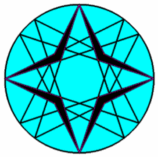QA-8 The Dual QA-/QL-Configuration
Let P1.P2.P3.P4 be the Reference Quadrangle.
Let L1 be the Trilinear Polar of P1 wrt P2.P3.P4.
Let L2 be the Trilinear Polar of P2 wrt P3.P4.P1.
Let L3 be the Trilinear Polar of P3 wrt P4.P1.P2.
Let L4 be the Trilinear Polar of P4 wrt P1.P2.P3.
In this way Quadrilateral L1.L2.L3.L4 is constructed.
Now it appears that (easy to prove algebraically):
P1 is the Trilinear Pole of L1 wrt L2.L3.L4.
P2 is the Trilinear Pole of L2 wrt L3.L4.L1.
P3 is the Trilinear Pole of L3 wrt L4.L1.L2.
P4 is the Trilinear Pole of L4 wrt L1.L2.L3.

So we started with a Reference Quadrangle P1.P2.P3.P4 which was converted to a Quadrilateral L1.L2.L3.L4 using Trilinear Polars wrt the QA-Component Triangles, which in turn was converted to the Reference Quadrangle using Trilinear Poles wrt the QL-Component Triangles.
It is evident now that when we had started with a Reference Quadrilateral L1.L2.L3.L4, then we would have found a Quadrangle P1.P2.P3.P4 using Trilinear Poles wrt the QL-Component Triangles, which in turn was transformed to the Reference Quadrilateral using Trilinear Polars.
This dual configuration was brought to light by Tsihong Lau. See [34], QFG#1457.
The story is not finished yet. It appears that:
- Each point of the Quadrangle in question is related to a line of the Quadrilateral in question and vice versa.
- The Pole/Polar-related Quadrangle and Quadrilateral share the same Diagonal Triangle. Note that the construction of the Diagonal Triangle of a Quadrangle (QA-Tr1) and the construction of the Diagonal Triangle of a Quadrilateral (QL-Tr1) are different. Denote QA-/QL-DT as the shared Diagonal Triangle.
- The correspondence of the QA-reference points and the QL-reference lines is defined by using trilinear poles/polars wrt the Component Triangles. However they can be substituted by using trilinear poles/polars wrt the Common QA-/QL-Diagonal Triangle, because they coincide.
So we can summarize by saying that there exists a dual QA/QL-configuration where QA and QL mutually are constructed by using the Trilinear Polar/Pole of corresponding Point/Line wrt their shared Diagonal Triangle.
For definition of Trilinear Pole and Trilinear Polar wrt a triangle see [13].
The Trilinear Pole is often called Tripole and the Trilinear Polar is often called Tripolar.
Quadri-Duals
There is more to say about this Dual QA/QL-configuration. Not only the defining points (vertices) of a Quadrangle or the defining lines of a Quadrilateral are objects of transformation by trilinear polar/trilinear pole transforms, also random points/lines can be transformed this way.
With respect to a triangle trilinear polars and trilinear poles often are called “duals” because used calculations are similar.
The same is true in the QA/QL-configuration. This was mainly figured out by Eckart Schmidt. See [34], QFG#1482,#1497,#1506,#1512,#1516.
Instead of Trilinear Poles there are QuadriLinear Poles and instead of Trilinear Polars there are QuadriLinear Polars.
Special is that existing transformations QA-Tf2 (Involutary Conjugate) and QL-Tf2 (QL-Line Isoconjugate) play a role in this.
Eckart made these schemes for the “Quadri-Duals” (QFG#1516):

So we have 2 Points and 2 Lines each having a double-function wrt another item.
Scheme showing the coherence in the system:

Note: QL-Tf11(P) is the dual of P and QA-Tf10(L) is the dual of L.
Quadri-Duals of lines/conics/curves
Last but not least the notion of duals in the Quadri-environment has these special properties wrt lines/conics/curves:
- The dual of a line will be a point (and vice versa). The dual of a DT-circumscribed conic will be a DT-inscribed conic (and vice versa). The dual of a QA-circumscribed conic will be a QL-inscribed conic (and vice versa). In general the dual of a conic will be a conic. See [34], Eckart Schmidt, QFG#1497.
- The dual of a curve is either the envelop of the duals of its points or the locus of the duals of its tangents. See [34], Bernard Keizer, QFG#1512.
- Duality swaps points of a curve and tangents to its dual curve (and vice-versa). See [34], Bernard Keizer, QFG#1760.
- For self-dual conics see [34], QFG#1523,#1524,#1525,#1527.
Summarizing it can be said that a Curve of points has a dual enveloped curve defined by the tangents to the curve, an enveloped curve has a dual curve by taking the duals of the enveloping lines.
Estimated human page views: 713
